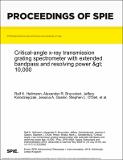Critical-angle x-ray transmission grating spectrometer with extended bandpass and resolving power > 10,000
Author(s)
Bruccoleri, Alexander R.; Kolodziejczak, Jeffery; Gaskin, Jessica A.; O'Dell, Stephen L.; Bhatia, Ritwik; Heilmann, Ralf K; Schattenburg, Mark Lee; ... Show more Show less
Download99051X.pdf (2.002Mb)
PUBLISHER_POLICY
Publisher Policy
Article is made available in accordance with the publisher's policy and may be subject to US copyright law. Please refer to the publisher's site for terms of use.
Terms of use
Metadata
Show full item recordAbstract
A number of high priority subjects in astrophysics can be addressed by a state-of-the-art soft x-ray grating spectrometer, such as the role of Active Galactic Nuclei in galaxy and star formation, characterization of the Warm-Hot Intergalactic Medium and the missing baryon problem, characterization of halos around the Milky Way and nearby galaxies, as well as stellar coronae and surrounding winds and disks. An Explorer-scale, largearea ( > 1,000 cm[superscript 2]), high resolving power (R =λ/Δλ > 3,000) soft x-ray grating spectrometer is highly feasible based on Critical-Angle Transmission (CAT) grating technology, even for telescopes with angular resolution of 5-10 arcsec. Still, significantly higher performance can be provided by a CAT grating spectrometer on an X-ray-Surveyor-type mission. CAT gratings combine the advantages of blazed reflection gratings (high efficiency, use of higher diffraction orders) with those of conventional transmission gratings (lowmass, relaxed alignment tolerances and temperature requirements, transparent at higher energies) with minimalmission resource requirements. They are high-efficiency blazed transmission gratings that consist of freestanding, ultra-high aspect-ratio grating bars fabricated from silicon-on-insulator (SOI) wafers using advanced anisotropic dry and wet etch techniques. Blazing is achieved through grazing-incidence reflection off the smooth grating bar sidewalls. The reflection properties of silicon are well matched to the soft x-ray band, and existing silicon CAT gratings can exceed 30% absolute diffraction efficiency, with clear paths for further improvement. Nevertheless, CAT gratings with sidewalls made of higher atomic number elements allow extension of the CAT grating principle to higher energies and larger dispersion angles, thus enabling higher resolving power at shorter wavelengths. We show x-ray data from CAT gratings coated with a thin layer of platinum using atomic layer deposition, and demonstrate efficient blazing to higher energies and much larger blaze angles than possible with silicon alone. We also report on measurements of the resolving power of a breadboard CAT grating spectrometer consisting of a Wolter-I slumped-glass focusing mirror pair from Goddard Space Flight Center and CAT gratings, performed at the Marshall Space Flight Center Stray Light Facility. Measurement of the Al Kα doublet in 18th diffraction order shows resolving power > 10,000, based on conservative preliminary analysis. This demonstrates that currently fabricated CAT gratings are compatible with the most advanced grating spectrometer instrument designs for future soft x-ray spectroscopy missions. Keywords: critical-angle transmission grating, x-ray spectroscopy, blazed transmission grating, soft x-ray,
grating spectrometer, high resolving power, atomic layer deposition
Date issued
2016-06Department
MIT Kavli Institute for Astrophysics and Space ResearchJournal
Proceedings Volume 9905, Space Telescopes and Instrumentation 2016: Ultraviolet to Gamma Ray
Publisher
SPIE
Citation
Heilmann, Ralf K., et al. "Critical-Angle x-Ray Transmission Grating Spectrometer with Extended Bandpass and Resolving Power > 10,000." Proceedings Volume 9905, Space Telescopes and Instrumentation 2016: Ultraviolet to Gamma Ray, 26 June - 1 July, 2016, Edinburgh, United Kingdom, edited by Jan-Willem A. den Herder et al., SPIE, 2016, p. 99051X. © 2016 SPIE.
Version: Final published version